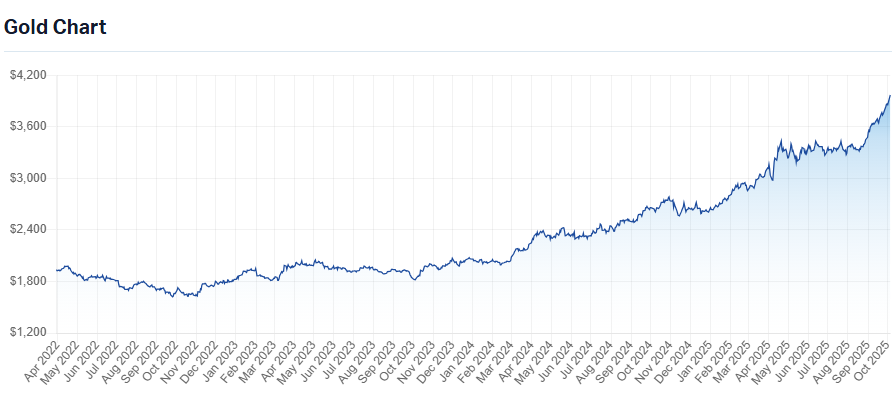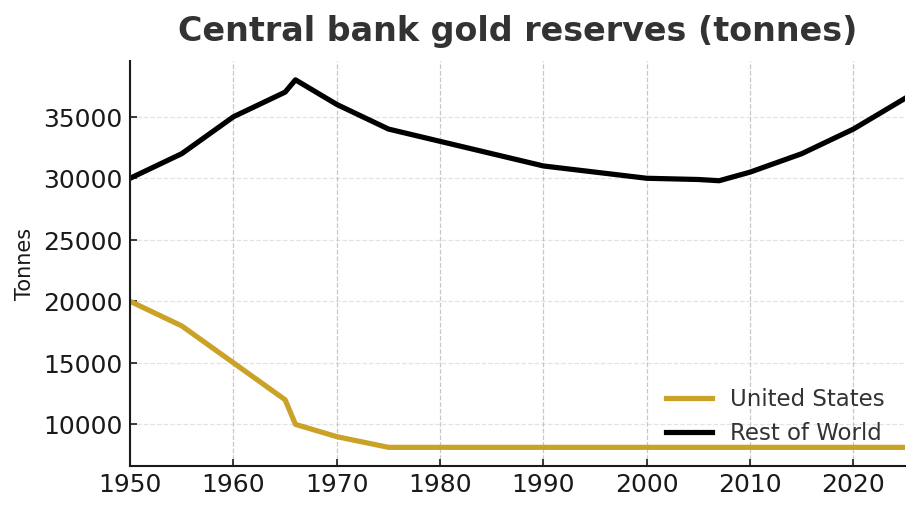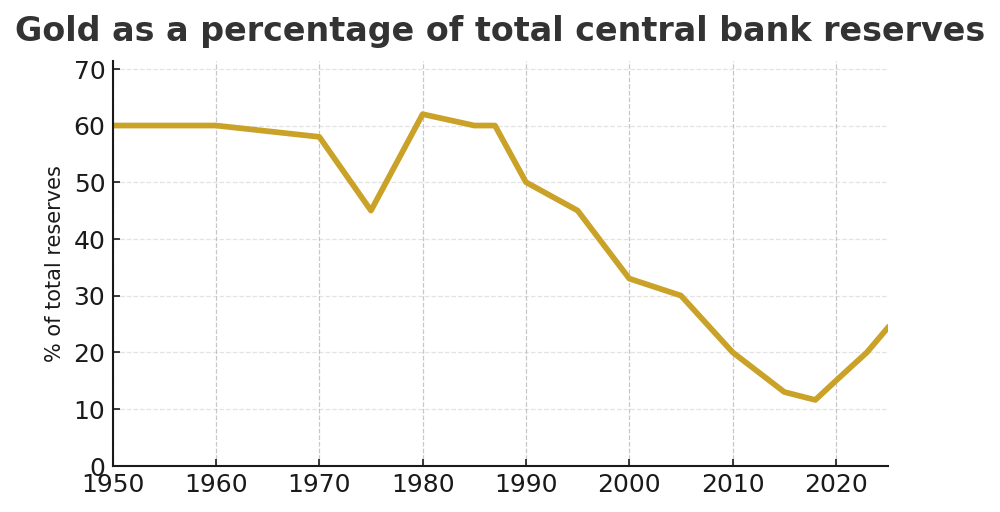Gold’s glittering run to US$6,000 could power NEM, NST, and EVN gains for years
Good as…
Gold has rarely looked so golden. After an 18-month rally that lifted it to a record high of more than US$4,000 per ounce on Wednesday, investors are asking the obvious: Can it keep going? The short answer is yes – at least while the same macro forces that have powered it remain in play.
Five key drivers have propelled gold’s rise so far:
- Persistent inflation pressures and falling real interest rates, which increase gold’s relative appeal as a store of value.
- Geopolitical risk – from Europe to the Middle East – and investor demand for safe-haven assets.
- Expanding fiscal deficits in the US and other advanced economies, raising doubts over sovereign credit quality.
- “De-dollarisation” and the end of US exceptionalism, as global trust in the greenback erodes.
- Accelerating central-bank gold purchases, as nations diversify reserves away from dollars.

This article focuses on the last two – the “new paradigm” in global reserves management – to gauge how far this gold bull market could still run (Hint: potentially quite a bit!).
The dollar’s loss is gold’s gain
“De-dollarisation” describes a slow but discernible shift away from the US dollar as the world’s default reserve and settlement currency. It’s not being caused by a single policy or event, but a gradual consequence of geopolitics, sanctions policy, and the rise of alternative economic blocs. In short, it’s the end of US exceptionalism – the notion that the dollar, US debt, and US financial institutions can indefinitely dominate global finance without consequence.
Three structural forces are driving the trend:
Sanctions risk and weaponisation of finance: The freezing of Russian reserves in 2022 jolted many central banks into realising that US-dollar assets carry political strings – for some nations, holding Uncle Sam’s buck to back one’s own currency has become a riskier pastime.
Geoeconomic fragmentation: BRICS expansion, China’s yuan-based trade settlements, and energy deals settled in local currencies have collectively diluted the dollar’s network effects.
Policy unpredictability in Washington: Mounting deficits and the second Trump administration’s punitive tariff policy, weakening international alliances, and challenges to the Fed’s independence – all help undermine confidence in the dollar’s long-term stability.
The International Monetary Fund’s quarterly COFER (Currency Composition of Official Foreign Exchange Reserves) data, released last week, provides the clearest evidence yet that this shift is real and accelerating. As of Q2 2025, the IMF estimates that the US dollar’s share of official reserves has declined to 42.6%, down from 60% in 2001. Meanwhile, if gold holdings are reclassified at prevailing market prices, their share of total reserves has climbed to 24.3%, more than doubling from its 11.6% nadir in 2018.


This reallocation represents an extraordinary reweighting of global monetary power. Out of roughly US$12.3 trillion in total allocated reserves, nearly US$3 trillion now sits in gold – a scale of diversification unseen in the modern fiat era. The IMF’s data, though neutral in tone, points unmistakably to a world where policymakers are actively reducing exposure to the US dollar and reinforcing their sovereign balance sheets with tangible assets.
Here, comments from Canadian investment bank Canaccord Genuity provide an important interpretive layer. In its latest “The Week in Gold” update released Monday, the firm notes that the ongoing migration in central-bank reserves “reflects both a deliberate hedge against US fiscal and political instability and a reassertion of monetary independence among emerging economies.”
Further, Canaccord observes that central-bank gold accumulation – now running at around 1,000 tonnes per year – has become one of the most powerful drivers of the gold price, absorbing roughly a quarter of global mine output. As the firm’s analysts put it, “Gold’s share of central-bank reserves continues to rise,” and if the current pace persists, “the market impact could remain profound.”
But wait, there’s more… potentially way more!
This idea – that the pervasive central-bank bid of the last 18-months is not just real, but structurally transformative – is a tantalising prospect for gold bulls. Canaccord’s historical analysis on central bank reserve holdings of gold makes for fascinating reading. Between 1950 and 1987, gold accounted for roughly 60% of total global reserves – nearly three times today’s share.
That said, much of that era coincided with the Bretton Woods framework and the early years of the post-gold-standard adjustment, so it’s debatable whether it’s a reasonable comparison period. It does, however, beg the question: What if central banks were to “re-gold” their balance sheets back toward that long-term average?
Canaccord’s analysts estimate that to raise gold’s share to 30% of reserves – halfway to the historic mean – would require an additional 2,700 tonnes per year of purchases for 10 years – equivalent to about 75% of current global annual mine production. Achieving that without drastically lifting prices would be impossible, they suggest.
Instead, they offer some "hypothetical goal posts":
- At the current accumulation rate of ~1,000 tonnes per year, gold would need to average about US $5,000 per ounce in ten years to represent 30% of reserves.
- If purchases accelerated toward the 2,700 tonnes per year scenario, gold would need to trade above US $6,000 per ounce to maintain equilibrium.
If Canaccord’s thought bubble turns out to be correct, it could deliver another 25–50% upside from current levels – a staggering proposition that underscores how powerful central-bank flows could become if de-dollarisation continues.
The IMF’s COFER breakdown reinforces this possibility. Gold’s share, while climbing, still lags behind the dollar’s, euro’s (16%), and even the combined non-traditional currencies (yen, sterling, yuan, Canadian and Australian dollars – together ~13%). But as the dollar share trends lower, a mere 5-percentage-point shift from USD holdings into gold could equate to over US$600 billion of incremental demand, or about 5,000 tonnes – roughly two years of mine output at current prices.
The trend is your friend – for now…
Gold’s extraordinary 18-month ascent rests on multiple macroeconomic pillars: Low real yields, geopolitical anxiety, fiscal excess, and the waning prestige of the dollar. Yet it’s the behaviour of central banks that increasingly sets the tone. Their actions are deliberate, opaque, and often politically motivated, making them powerful but unpredictable participants in the market.
If the de-dollarisation trend deepens and central banks continue to exchange dollars for shiny, yellow metal, this gold bull market may only be in its infancy. Still, no trend lasts forever. Gold’s glittering run could yet face its own reckoning if the same macroeconomic winds that created it shift – and history suggests they could reverse rapidly and without warning.
Five warning signals to watch:
- Resurgent real interest rates – if the Fed remains cautious while inflation cools, real yields could rise and dull gold’s shine (hmm… this one seems to be in play 🤔).
- A stronger US dollar if US growth outpaces the rest of the world, capital flows into US assets could lift the dollar and weigh on gold (not a major threat for now, given recent US economic data and the DXY’s long-term downtrend…).
- Improved fiscal discipline or reduced geopolitical risk, lowering demand for safe havens (Ha! US government shutdown, anyone? Not likely any time soon…)
- A slowdown or reversal in central-bank buying, particularly from China or emerging markets (a big question mark – data from the IMF and World Gold Council will be key here…)
- Technological or alternative-asset competition, such as tokenised reserves or renewed enthusiasm for cryptocurrencies (i.e. Bitcoin’s “digital gold” narrative makes a comeback…)
For now, though, the momentum is unmistakably bullish. Gold has reclaimed its monetary relevance not because investors suddenly fell in love with it, but because central banks did.
References:
- Canaccord Genuity, “The week in gold: Economic fog” – 6 Oct 2025
- IMF, “IMF Data Brief: Currency Composition of Official Foreign Exchange Reserves” – 2 Oct 2025
This article first appeared on Market Index on Tuesday 7 October 2025.
5 topics
19 stocks mentioned

